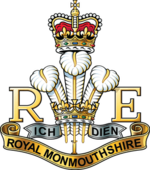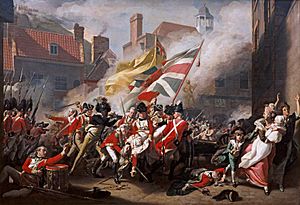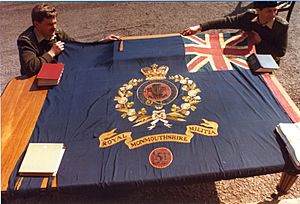Royal Monmouthshire Royal Engineers facts for kids
Quick facts for kids Royal Monmouthshire Royal Engineers (Militia) |
|
|---|---|

Insignia of the RMRE
|
|
| Active | 1539–present |
| Country | |
| Branch | |
| Type | Field Engineers |
| Size | Regiment 515 personnel |
| Part of | 25 (Close Support) Engineer Group |
| Regimental HQ | Monmouth Castle, Monmouth |
| March | Ap Jenkyn (Regimental Quick March) |
| Engagements | |
| Commanders | |
| Royal Honorary Colonel | The Duke of Gloucester |
| Insignia | |
| Arm Badge | Militia Flash |
The Royal Monmouthshire Royal Engineers (Militia) is a very old and important part of the British Army Reserve. This group of soldiers was first started in 1539 by King Henry VIII. This makes them the second oldest regiment in the entire British Army! Only the Honourable Artillery Company is a little older, formed in 1537.
In 1660, the Royal Monmouthshire Royal Engineers (Militia) became a special type of army unit called a militia. Later, in 1877, they joined the Royal Engineers, who are army builders and engineers.
Contents
A Look at Their History

How They Got Two 'Royal' Names
This army group started in 1539 as a local force to help the King. It was first called a posse comitatus and then a "trained band." By 1660, it became a proper militia unit.
It's quite special because the word 'Royal' appears twice in its name! The first 'Royal' was added in 1804. Back then, it was known as the Monmouth and Brecon Militia. The second 'Royal' was given in 1877. This happened when the unit changed from being infantry (foot soldiers) to becoming part of the growing Royal Engineers.
On April 1, 1967, the regiment grew even bigger. It took in other engineer units like the 43rd Wessex Division RE, the 48th South Midland Division RE, and the 53rd Welsh Division RE.
Who Is the Oldest?
There was a friendly disagreement about which army unit was the oldest. The Honourable Artillery Company (HAC) believed they were older because their records show they formed in 1537. This was two years before the Royal Monmouthshire Royal Engineers (Militia).
However, in 1930, a group called the Army Council looked closely at all the army's records. King George V agreed that the Royal Monmouthshire Royal Engineers (Militia) were actually the most senior regiment. This was because of their special status as a militia unit.
In 1957, the matter was looked at again. Queen Elizabeth II also agreed that the Royal Monmouthshire Royal Engineers (Militia) were the senior regiment. She approved the decision from the Honours and Distinctions Committee.
The Royal Jersey Militia Joins

In 2007, the Jersey Militia became part of the Royal Monmouthshire Royal Engineers (Militia). The Jersey Militia itself has a long history. It was formed in 1337 when King Edward III told everyone on the islands to be ready for a possible war with France.
This militia bravely defended their island from pirate attacks and a French invasion attempt in 1549. They also played a key role in the Battle of Jersey. Because of their actions in that battle, they earned the 'Royal' title for themselves.
How the Regiment Is Organized Today
The Royal Monmouthshire Royal Engineers (Militia) is set up in different groups:
- Regimental Headquarters and Headquarters Troop, located at Monmouth Castle. This is like their main office.
- 100 (Militia) Field Squadron, at Chapman House, Cwmbran.
- 1 Troop, at Artillery Grounds, Bristol.
- Cardiff Troop.
- 108 (Welsh) Field Squadron (Militia), at John Chard VC House, Swansea.
- 225 (City of Birmingham) Field Squadron (Militia), at Gundolph House, Oldbury.
- 1 Troop, at Baskeyfield House, Stoke-on-Trent.
- 2 Troop, in Cannock.
- Jersey Field Squadron (Royal Militia of the Island of Jersey), in Saint Helier, Jersey.
- Guernsey Troop, at Saint Peter Port, Guernsey.
Regimental Museum
You can learn more about the Royal Monmouthshire Royal Engineers at their museum. It is located inside Monmouth Castle.
Notable People
Some interesting people have been part of this regiment:
- Jules Hudson: He is a television producer and presenter. You might know him from the BBC show Escape to the Country.
- Jon Latimer: He was a military historian and author. He also taught part-time at Swansea University.
Order of Importance
| Preceded by Royal Corps of Army Music |
Order of Precedence | Succeeded by Honourable Artillery Company |


